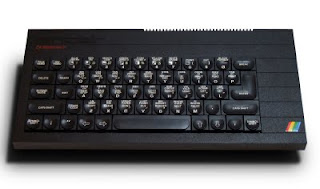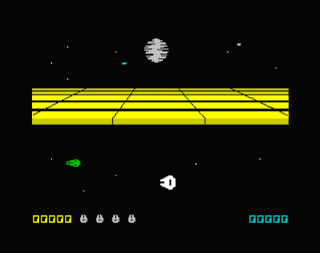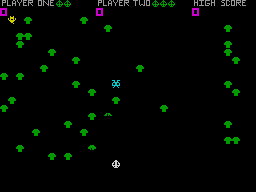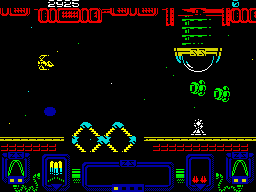Another lesser known gem from the same team that brought us the excellent (but tough!) Fahrenheit 3000, Turtle Timewarp was released for the ZX Spectrum by Perfection Software in July 1984.
Turtle Timewarp was based on the classic arcade game Turtles
This classic ZX Spectrum game was set in a future where the world had suffered from thermonuclear destruction. The last humans had long since departed and the main life form left behind was turtles.
You took the role of the main turtle - the biggest and strongest of all the survivors. It was up to you to collect the smaller turtles and carry them (on your back) to the relative safety of the remaining human homes.
In amongst all of this some aliens had paid the earth a visit and left behind a series of timegates which you used to 'warp' to other lands (other levels in the game). Time to do the 'Turtle Timewarp'! Let the retro gaming commence!

Things are never that simple though. In this entry in ZX Spectrum retro gaming the land was populated with various mutated creatures who all had a desire to munch away at any shell carrying creature - namely you. A creature could be temporarily halted by dropping a stun bomb in it's path which would leave it dazed for a few seconds. You were only allowed one stun bomb on the game screen at a time though.
Every now and again your lair would appear in the centre of the screen where you could collect extra stun bombs - and you needed them.
Each screen was maze like in design - slightly reminiscent of Pac Man in look and feel. Some areas of the maze had little 'inshots' and in each one of these there was a question mark (eight question marks in total).
The question marks would either hold a small buddy for you to carry to the human house (which appeared once you picked up the little critter), or another mutated nasty. You would not know either way until you ran into the question mark. If it was a nasty you had to be quick smart and do a runner before it killed you!
 Your turtle always 'ran' under it's own steam making this arcade game fast moving at all times. So, if you pressed 'left' it would continue moving to the left until it either hit a wall or you changed direction. This aspect required that you timed your movements well to make the character move around the maze smoothly and took a few goes to get the hang of.
Your turtle always 'ran' under it's own steam making this arcade game fast moving at all times. So, if you pressed 'left' it would continue moving to the left until it either hit a wall or you changed direction. This aspect required that you timed your movements well to make the character move around the maze smoothly and took a few goes to get the hang of.
To complete the level you had avoid the nasties which constantly roamed around the maze and collect five turtles and drop them off at each human house.
Once all five had been deposited the warp gate would appear in the centre of the screen which you could would jump into and materialise on the next level. Each level was different in layout - requiring a slightly different strategy to complete. It goes without saying that each new level was more difficult than the last!
On Release:
Turtle Timewarp was another title from the then newly formed Perfection Software which was generally recieved well by ZX Spectrum magazines and gamers alike. It was original in concept (as far as Speccy games go there was nothing else like it), and people enjoyed the nice theme tune at the beginning coupled with good presentation. The game was (for most!) far from easy, and took a few plays to get into. Once you got the hang of it you realised just how addictive it could be. The graphics were functional and good enough for this type of game - the turtle retreating into his shell was a nice touch! It was generally regarded as a nice and simple game which managed to combined puzzle elements with arcade action well. At only £4.95 it represented good value for money too.
The test of time:
Well, here in Spectrum Games we can see that Turtle Timewarp has aged considerably. This is mainly due to the simple nature of the graphics, but once you get past the scant visuals, the gameplay becomes apparent. It's still fun, fast moving and hectic, and certainly has that 'one more go' factor. This game is not easy by any means (I still can't get past level three!) but it does keep you coming back for more. A good little retro game.
Grab your best turtle-neck sweater and do the timewarp again!
We recommend getting hold of the real ZX Spectrum hardware, but if not then download a ZX Spectrum emulator and download Turtle Timewarp for the ZX Spectrum.
Alternatively you could try and play it online.
Please see our other ZX Spectrum retro game reviews - all links are listed in alphabetical order. Cheers guys.
GENRE: Arcade puzzle game
RELEASE DATE: July 1984
RELEASED BY: Perfection Software
DEVELOPER(S): Tim Williams and Chris Jones
PRICE: £4.95 (re-released the following year on a budget label at £2.99)
Let's do the timewarp agaaain! Turtle Timewarp in Spectrum Games:







 Get Green Beret
Get Green Beret






%5B1%5D.gif)






 ZX Spectrum Games Robin Of The Wood
ZX Spectrum Games Robin Of The Wood










